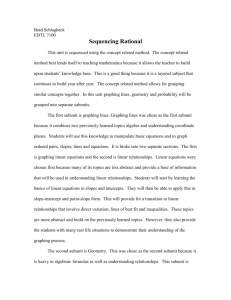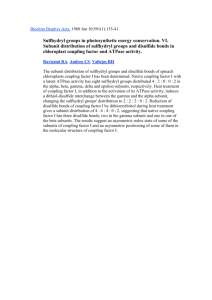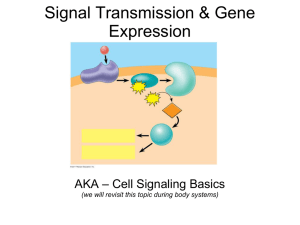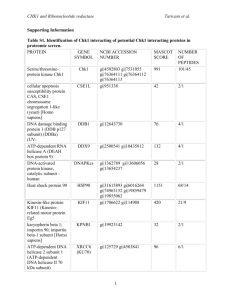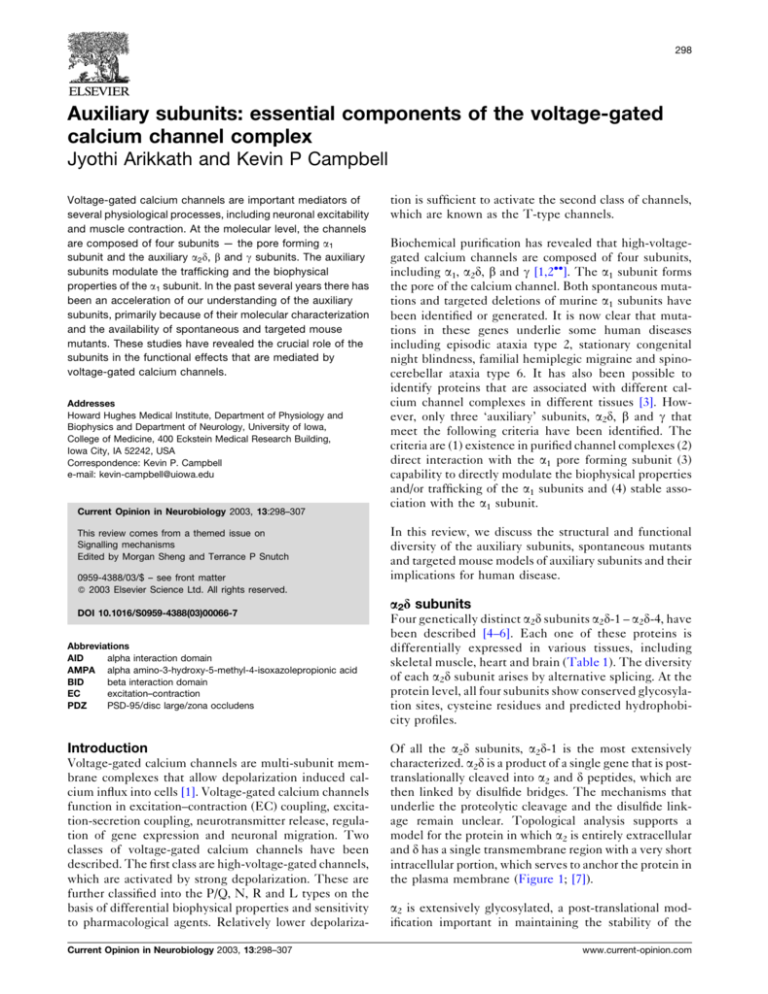
298
Auxiliary subunits: essential components of the voltage-gated
calcium channel complex
Jyothi Arikkath and Kevin P Campbell
Voltage-gated calcium channels are important mediators of
several physiological processes, including neuronal excitability
and muscle contraction. At the molecular level, the channels
are composed of four subunits — the pore forming a1
subunit and the auxiliary a2d, b and g subunits. The auxiliary
subunits modulate the trafficking and the biophysical
properties of the a1 subunit. In the past several years there has
been an acceleration of our understanding of the auxiliary
subunits, primarily because of their molecular characterization
and the availability of spontaneous and targeted mouse
mutants. These studies have revealed the crucial role of the
subunits in the functional effects that are mediated by
voltage-gated calcium channels.
Addresses
Howard Hughes Medical Institute, Department of Physiology and
Biophysics and Department of Neurology, University of Iowa,
College of Medicine, 400 Eckstein Medical Research Building,
Iowa City, IA 52242, USA
Correspondence: Kevin P. Campbell
e-mail: kevin-campbell@uiowa.edu
Current Opinion in Neurobiology 2003, 13:298–307
This review comes from a themed issue on
Signalling mechanisms
Edited by Morgan Sheng and Terrance P Snutch
0959-4388/03/$ – see front matter
ß 2003 Elsevier Science Ltd. All rights reserved.
DOI 10.1016/S0959-4388(03)00066-7
Abbreviations
AID
alpha interaction domain
AMPA alpha amino-3-hydroxy-5-methyl-4-isoxazolepropionic acid
BID
beta interaction domain
EC
excitation–contraction
PDZ
PSD-95/disc large/zona occludens
Introduction
Voltage-gated calcium channels are multi-subunit membrane complexes that allow depolarization induced calcium influx into cells [1]. Voltage-gated calcium channels
function in excitation–contraction (EC) coupling, excitation-secretion coupling, neurotransmitter release, regulation of gene expression and neuronal migration. Two
classes of voltage-gated calcium channels have been
described. The first class are high-voltage-gated channels,
which are activated by strong depolarization. These are
further classified into the P/Q, N, R and L types on the
basis of differential biophysical properties and sensitivity
to pharmacological agents. Relatively lower depolarizaCurrent Opinion in Neurobiology 2003, 13:298–307
tion is sufficient to activate the second class of channels,
which are known as the T-type channels.
Biochemical purification has revealed that high-voltagegated calcium channels are composed of four subunits,
including a1, a2d, b and g [1,2]. The a1 subunit forms
the pore of the calcium channel. Both spontaneous mutations and targeted deletions of murine a1 subunits have
been identified or generated. It is now clear that mutations in these genes underlie some human diseases
including episodic ataxia type 2, stationary congenital
night blindness, familial hemiplegic migraine and spinocerebellar ataxia type 6. It has also been possible to
identify proteins that are associated with different calcium channel complexes in different tissues [3]. However, only three ‘auxiliary’ subunits, a2d, b and g that
meet the following criteria have been identified. The
criteria are (1) existence in purified channel complexes (2)
direct interaction with the a1 pore forming subunit (3)
capability to directly modulate the biophysical properties
and/or trafficking of the a1 subunits and (4) stable association with the a1 subunit.
In this review, we discuss the structural and functional
diversity of the auxiliary subunits, spontaneous mutants
and targeted mouse models of auxiliary subunits and their
implications for human disease.
a2d subunits
Four genetically distinct a2d subunits a2d-1 – a2d-4, have
been described [4–6]. Each one of these proteins is
differentially expressed in various tissues, including
skeletal muscle, heart and brain (Table 1). The diversity
of each a2d subunit arises by alternative splicing. At the
protein level, all four subunits show conserved glycosylation sites, cysteine residues and predicted hydrophobicity profiles.
Of all the a2d subunits, a2d-1 is the most extensively
characterized. a2d is a product of a single gene that is posttranslationally cleaved into a2 and d peptides, which are
then linked by disulfide bridges. The mechanisms that
underlie the proteolytic cleavage and the disulfide linkage remain unclear. Topological analysis supports a
model for the protein in which a2 is entirely extracellular
and d has a single transmembrane region with a very short
intracellular portion, which serves to anchor the protein in
the plasma membrane (Figure 1; [7]).
a2 is extensively glycosylated, a post-translational modification important in maintaining the stability of the
www.current-opinion.com
Auxiliary subunits of voltage gated calcium channels Arikkath and Campbell
299
Table 1
Chromosomal location, functional effects and tissue distribution of the auxiliary subunits of the voltage-gated calcium channels.
Subunit
Human chromosomal
location
Functional effects
Tissue distribution
References
a2d-1
7q21-q22
Membrane trafficking of a1
Increase in current amplitude
activation/inactivation kinetics
Voltage dependence of activation
Brain, heart, skeletal muscle
[7,9]
a2d-2
3p21.3
Increase in current amplitude
Lung, testis, brain, heart, pancreas,
prostrate, skeletal muscle, spinal cord
[4,5]
a2d-3
3p21.1
Increase in current density
Voltage dependence of activation
Steady state inactivation
Brain, heart, skeletal muscle
[4]
a2d-4
12p13.3
Increase in current amplitude
Heart, skeletal muscle, intestine, fetal liver
erythroblasts, adrenal gland, pituitary
[6]
b1
17q21-q22
Skeletal excitation–contraction coupling
Membrane trafficking of a1
Targeting of a11.1 to triads
Increase in current amplitude
activation/inactivation kinetics
b1a-skeletal muscle, brain (other isoforms)
[16,23]
b2
10p12
Increase in current amplitude
activation/inactivation kinetics
Targeting of a11.4 in retina
Membrane trafficking of a1
Heart, lung, trachea, aorta, brain
[15,29]
b3
12q13
Increase in current amplitude
activation/inactivation kinetics
Membrane trafficking of a1
Smooth muscle, trachea,
aorta, lung, brain
[27,30,31]
b4
2q22-q23
Increase in current amplitude
Activation/inactivation kinetics
Membrane trafficking of a1
Brain
[27,32]
g1
17q24
Inhibitory effect
Activation/inactivation kinetics
Skeletal muscle
[33]
g2
22
Inhibitory effect
Activation/inactivation kinetics
Trafficking of AMPA receptor
Brain
[34–37,38]
g3
16p13.1-p12
Activation/inactivation kinetics
Brain
[35–37]
g4
17q24
Inactivation kinetics
Heart, lung, brain, prostate, spinal cord
[35–37]
g5
17q24
?
Brain
[35]
g6
19q13.4
Reduction of current amplitude
(low voltage-gated calcium channel)
Heart, skeletal muscle, brain
[52]
g7
19q13.4
Reduction of current amplitude
Brain, heart, lung, testis
[40]
g8
19q13.4
?
Brain, testis, spinal cord
[35,36]
interaction with a1 and is a major determinant of the
protein’s ability to stimulate the current amplitude [7].
There are forms of a2d that are differentially glycosylated,
however, the physiological consequences of this remain
unclear. It is apparent that glycosylation of proteins has
important functional consequences, and genetic defects
in the pathways that enable glycosylation underlie some
human diseases [8]. Given the widespread tissue distribution of a2d, the important physiological role, and the
extensive post-translational modifications, it might be
worthwhile to dissect out pathways that allow these
post-translational modifications.
www.current-opinion.com
Interestingly, although d is the portion of the protein that
is anchored in the membrane, it is a2 that interacts with
the a1 subunit [9]. This interaction is entirely extracellular, as the substitution of d with an unrelated transmembrane domain does not prevent the interaction. The
corresponding region on a1 that interacts with a2d is in
the 3rd transmembrane domain. However, this domain is
not sufficient to mediate interaction, which suggests that
secondary interaction sites may exist. There is no evidence for the interaction of a2d and b subunits and such
interaction appears to be unlikely given the entirely
cytosolic localization of b and the small region of a2d
Current Opinion in Neurobiology 2003, 13:298–307
300 Signalling mechanisms
Figure 1
Subunit interaction
N
α2
Subunit interaction
-S-S-
α1
GLWXXC motif
Proteolysis and
disulfide bridge
δ
γ
Extracellular
Membrane anchor
Intracellular
PDZ binding
motif
C
N
C
N
SH3 domain
C
BID - Subunit interaction
ER retention signal
PDZ-like domain
N
β
C
Guanylate kinase-like domain
Current Opinion in Neurobiology
Predicted membrane topology, subunit interactions and structural domains of the auxiliary subunits of the voltage-gated calcium channels. The
voltage-gated calcium channels are composed of the pore forming a1 subunit and the auxiliary a2d, b and g subunits. The a2d and g subunits
contain transmembrane domains, whereas the b subunit is entirely intracellular. All three auxiliary subunits interact directly with the a1 subunit, with no
known inter-auxiliary subunit interactions. Each of the auxiliary subunits contains unique structural domains as shown.
that is intracellular. In addition, there is currently no
evidence for direct subunit interaction between the a2d
and g subunits.
Functional effects
The co-expression of a2d-1 allows an enhancement in the
membrane trafficking of a1, associated with an increase in
the number of ligand binding sites [10]. In addition,
coexpression of the a2d-1 subunit causes an increase in
current amplitude, faster activation and inactivation
kinetics and a hyperpolarizing shift in the voltage dependence of activation. Some of these effects can be observed
in the absence of the b subunit, whereas in other cases,
the co-expression of b is required.
Interestingly, unlike a2d-1, the a2d-2 subunit only appears
to increase the current amplitude, with no significant
changes in the biophysical properties [5] of channels composed of a11.2 or a12.2.
In the case of co-expression of the a2d-3 subunit with
a11.3, the effects are more noticeable with co-expression of
Current Opinion in Neurobiology 2003, 13:298–307
b. When a2d-3 was co-expressed with the a11.3 subunit,
the current density, time course of inactivation, and voltage dependence of steady state inactivation were unaffected [4]. There was, however, a slight shift in the
activation curve in the hyperpolarizing direction. In contrast, when a2d-3 was co-expressed with b, there was a
significant increase in the current density, a hyperpolarizing shift in the voltage dependence of current activation,
and a shift of the inactivation curve in the hyperpolarizing
direction. Similarly, a2d-3 shifts the steady state activation
and inactivation curves of a12.3/b3 channels in the hyperpolarizing direction [7]. Studies with a2d-1 suggest that the
increase of the current amplitude requires the presence of
an intact a2 subunit, whereas the modulation of the other
biophysical properties requires the d subunit [11].
a2d-4 is the most recently described subunit [6] and the
least understood. Similar to the other a2d subunits, a2d-4
enhances the currents generated by the a12.1/b3 subunits.
The effect of a2d-4 on the other biophysical properties of
the currents and the ability to modulate other a1 subunits
remains to be determined.
www.current-opinion.com
Auxiliary subunits of voltage gated calcium channels Arikkath and Campbell
Although it is clear that the a2d subunits are components
of the high-voltage-gated calcium channel complexes, the
native channels that they are associated with remain to be
resolved. a2d-1 is the only a2d subunit that has been
extensively characterized by biochemical analysis. The
availability of specific antibodies to each of the a2d
subunits and channel purification techniques will aid in
clarifying native channel composition. The a2d subunit is
known to bind gabapentin, a widely used anticonvulsant
drug, suggesting that it might be an important target for
therapeutic intervention.
Mouse models
The ducky (du/du) mouse
The du/du mice have a genomic rearrangement that
results in a truncated transcript for the a2d-2 gene and
smaller protein product of a2, with a complete loss of d
[12,13]. Consequently, the protein is not anchored in
the plasma membrane and appears to be entirely intracellular in transfected cells. Functionally, this truncated
protein cannot compensate for the loss of the full-length
protein. Electrophysiological studies reveal a severe
reduction in the P-type current density in du/du mice
with no change in the single channel conductance. It is
not clear if this is caused by of loss of function or if the
aberrant protein interferes with the complex formation or
trafficking of the channel.
The ducky mice are smaller in size than their corresponding wild type littermates and fail to survive
beyond about five weeks. The mice are characterized
by a loss of balance and coordination (ataxia) and brief
attacks of abnormal involuntary movement or posture
(paroxysmal dyskinesia) and exhibit synchronous spike
wave discharges, accompanied by behavioral arrest
and response to ethosuximide (an anticonvulsant drug
that acts on the brain and nervous system in the
treatment of epilepsy). At the cellular level, Purkinje
neurons in the ducky mice appear to not be completely
developed, smaller and possess incomplete branching
[12,13].
Mice with targeted deletions or spontaneous mutations
in a2d-1, a2d-3 and a2d-4 have not yet been described. In
the future, it would be interesting to generate such mice
to assess the specific roles of each of the a2d subunits.
These studies may include the role of a2d in skeletal and
cardiac EC coupling, independent of its role in the
stimulation of the voltage-gated calcium currents.
Furthermore, as it appears in cell expression studies that
the a2d subunits might be functionally heterogeneous, it
would be interesting to assess if the loss of one of the
subunits might lead to functional compensation by the
others. The widespread expression of the a2d subunits
and their role in the modulation of calcium channels
suggests that the loss of the protein might lead to severe
physiological consequences.
www.current-opinion.com
301
b subunits
Four distinct genes encode the b subunits (b1b4) and
numerous splice variants are known [14]. All four of the
genes are expressed in the brain. A distinct isoform of the
b1 subunit, the b1a isoform, is a component of the skeletal
muscle voltage-gated calcium channel. In addition to
their expression in the brain, each b subunit shows
differential expression in other tissues (Table 1).
b is the only subunit of the channel that is entirely
cytosolic. Some forms, however, including b1b and rat
b2a isoforms, can associate with the plasma membrane
independent of the a1 subunit. This is mediated by the
presence of acidic motifs in the protein [15] or partly by
lipid modification [16]. The ability of the rat b2a to be
inserted in the membrane is unique among the b2a isoforms and is mediated by two amino-terminal cysteine
residues that are palmitoylated and allow membrane
insertion of the protein.
b subunits have a general structure comprised of five
different domains, with the two central domains sharing
significant homology amongst the b subunits [17]. The
amino and carboxy termini are relatively less well conserved. Modeling studies predict the existence of at least
three domains in the protein, namely a PDZ-like domain
(PSD-95/disc large/zona occludens), an SH3 domain and a
guanylate kinase-like domain. The physiological significance of the different domains and the distinct protein–
protein interactions that they mediate is only just beginning to be understood.
b subunits associate with the a1 subunit predominantly
through a highly conserved high affinity interaction that is
mediated by the Alpha Interaction Domain (AID) in the
a1 subunit [18] and a corresponding Beta Interaction
Domain (BID) in the b subunit [19]. A mutation in the
AID severely affects membrane trafficking and the ability
of b to bind to a1. In addition to the high affinity AID/BID
interaction sites, secondary interaction sites have been
described for b4 and b3. The presence of the conserved
interaction domains on a1 and b subunits allows for
diversity of their interaction both in vivo and in vitro.
This is reflected in the heterogeneity of b subunits that
are associated with different channel complexes [20].
However, despite the ability of b subunits to form heterogeneous complexes, it is clear that each type of channel has a predominant b subunit associated with it. b4 is
the predominant subunit associated with the P/Q-type
channels, whereas the N-type channels predominantly
contain b3.
Functional effects
The b subunit aids in the trafficking of a1 to the plasma
membrane, partly by its ability to mask an endoplasmic
reticulum retention signal in the a1 subunit [21]. In
addition to its role in membrane trafficking, the b subunit
Current Opinion in Neurobiology 2003, 13:298–307
302 Signalling mechanisms
modulates the biophysical properties of the channel with
characteristics specific to the a1b combination [22]. The
b subunit can accomplish these dual functions independently, as illustrated by its ability to modulate the biophysical properties of channels in the presence of a
mutation in the AID region, which disrupts its ability
to enhance membrane trafficking of a1. The mechanism
for these independent functions of the same subunit is
not clear, and it has been suggested to be a function of the
ability of some of the b subunits to associate with other
intracellular loops of the channel through interactions that
are weaker than those described for the AID/BID.
In addition to their general role in enhancing trafficking of
a1, some b subunits have additional unique functions. b1
is necessary for the targeting of a11.1 to the triads [23]. In
addition to its role in trafficking a1, b1a in skeletal muscle
functions in EC coupling [24]. The carboxy-terminal of
b1b contains a motif that allows the protein to be targeted
to the plasma membrane in the absence of a1. The aminoterminal of b2a allows the protein to be anchored at the
membrane and reduce the channel inactivation of a12.1
channels [25]. The carboxy and amino termini of b4 allow
the localization of the protein to presynaptic sites [26].
There is also evidence that the b subunit may be involved
in targeting of the channel complex to certain cellular
locations [27].
Regulation of calcium channels also occurs through
modification of the b subunits. b2a is a substrate for
protein kinase A, and phosphorylation of b2a is important
for the ability of protein kinase A to stimulate the
currents generated by the a11.2 channels in mammalian
expression systems and in cardiac myocytes. Recent
studies also demonstrate a direct role for the b subunit
in the modulation of the a12.2 channels through the
mitogen-activated protein kinase (MAPK) pathway
[28]. It is clear that the functional effects of the b
subunits, and hence the calcium channels, can be modulated in response to a variety of cellular stimuli. Stimulus
induced modification of the auxiliary subunits may provide an additional level of modulation of intracellular
communication mediated by the voltage-gated calcium
channels.
Mouse models
b1 null mice
The b1 subunit is expressed in a wide variety of tissues. A
specific isoform, b1a, is expressed in skeletal muscle. b1
null mice have been generated by conventional gene
targeting, but homozygous null mice die at birth. The
fetuses of these mice are unable to move, show reduced
L-type currents, have greatly reduced amounts of a11.1
and show a reduction in muscle mass with structural
abnormalities [23]. Further studies have revealed a lack
of EC coupling in these mice, and revealed a direct role
for b1 in EC coupling. The early lethality of these mice
Current Opinion in Neurobiology 2003, 13:298–307
has not permitted a close examination of the effects of the
loss of b1 in the brain. However, recently a mouse model
has been generated that expresses b1 in the skeletal
muscle but not other tissues [29]. The expression of b1
in skeletal muscle allows bypass of the perinatal lethal
phenotype. This mouse should provide a good model
system to examine the effects of the loss of b1 in the brain.
b2 null mice
Mice that are deficient in b2 have been generated by
conventional gene targeting [29]. Homozygous null mice
are embryonic lethal, presumably because of cardiac
defects, as b2 is a component of the cardiac voltage-gated
calcium channel. It is unclear if b2 has a role in the cardiac
EC coupling, similar to b1 in skeletal muscle.
Mice that express b2 in the cardiac tissue, which allows
bypass of the early lethal phenotype, have been generated [29]. A close examination of these mice has revealed
retinal abnormalities, comparable with that observed in
human congenital stationary night blindness. The
absence of b2 also results in the distortion of the distribution of a11.4. The availability of this mouse model should
allow finer dissection of the role of b2 in the brain.
b3 null mice
b3 null mice have been generated by conventional gene
targeting strategy [30,31]. These mice appear to be normal in appearance with no obvious phenotype. A closer
histological examination of different brain regions has
revealed no gross morphological changes. In addition,
there are no detectable abnormalities in the heart, lung,
kidney, spleen, pancreas, liver, ovary or testis. The loss of
b3 results in the reduction of the N- and L-type currents
and an alteration of the kinetics of the P/Q-type currents
in the superior cervical ganglia. In smooth muscle, the
lack of b3 does not diminish L-type currents or affect
smooth muscle contractility [30]. However, on a high salt
diet, mice that lack b3 have elevated blood pressure,
suggesting a role for the voltage-gated calcium channels
in maintaining blood pressure.
Lethargic mice
The lethargic (lh/lh) mouse arose as a spontaneous mutation in the gene encoding the b4 subunit. The mutation in
the lh/lh mouse has been characterized as a 4 bp insertion
[32] within a 50 splice site. This causes exon skipping and
the generation of transcripts with a premature stop codon.
The predicted protein, if produced, would be severely
truncated and lack the BID, the domain that allows
interaction with a1. Subsequent studies [32] have demonstrated that there is no detectable protein, indicating that
this is indeed a null mutation.
Lethargic mice exhibit ataxia, lethargic behavior and
spontaneous focal motor seizures. A second seizure type,
brief episodes of behavioral immobility, accompanied by
www.current-opinion.com
Auxiliary subunits of voltage gated calcium channels Arikkath and Campbell
generalized cortical spike wave discharges is also
observed. These seizures resemble the absence seizures
of human petit mal epilepsy. The mice survive anywhere
from 15 days to 2 months, show a reduction in body
weight, immunological problems and increased mortality.
Mice that survive beyond two months recover much of
their immune function and body weight but exhibit
reduced fertility. The absence of b4 does not result in
any change in the P/Q-type currents in the Purkinje
neurons [32]. The ability of b subunits to form heterogenous complexes with a1 subunits is reflected in the
compensation for the loss of b4 in the lethargic mouse
[32]. However, the compensation is not functionally
complete, as the lh/lh mouse still has a severe phenotype,
indicating that all functions that are associated with b4 are
not completely compensated for by the association of
other b subunits with neuronal calcium channels. It is
tempting to speculate that one of the reasons for the lack
of compensation is due to the ability of b4 to interact
specifically with certain cellular proteins that allow specific downstream effects.
It would be interesting to examine the effect of the loss of
b2 and b1 on neuronal excitability. Mice that lack b3 and
b4 in the brain display different phenotypes, suggesting
that b subunits are not functionally equivalent. In the
future, it would be interesting to generate mice that lack
two or more b subunits to understand the complete
effects of the loss of b subunits in the nervous system.
c subunits
g was originally known to only be associated with the
skeletal muscle voltage-gated channel complex [33].
However, recent studies with the stargazer mouse
revealed the existence of a neuronal g subunit [34].
Subsequently, several g subunits have been identified
[35–38]. The g1 subunit is most closely related to the g6
subunit, while g2, g3, g4 and g8 share significant homology.
The expression of the g subunits shows wide tissue
distribution (Table 1), but the g1 subunit expression is
restricted to skeletal muscle. The g2 and g3 subunits are
associated with the P/Q- and the N-type channels
[2,36]. The in vivo partners of the other g subunits
remain to be identified.
g subunits share a conserved four transmembrane domain
topology with predicted intracellular amino and carboxy
termini. In addition, g subunits share common features
including a GLWXXC amino acid motif in the first
extracellular loop and several conserved residues. Neuronal g subunits also share a consensus site for cAMP/
cGMP phosphorylation. Consensus sites for N-linked
glycosylation sites are present in the first extracellular
loop. The physiological consequences of glycosylation
are not yet understood. It would be interesting to determine if glycosylation plays a role in stabilizing the interaction of g with the voltage-gated calcium channels,
www.current-opinion.com
303
similar to that observed for a2d. g2, g3, g4, g5, g7 and g8
subunits contain a PDZ binding or related motif at the
carboxy terminus.
Interestingly, g1, g2, g3 and g4 can traffic to the plasma
membrane in the absence of the other subunits of the
calcium channel in transiently transfected mammalian
cells [39]. However, this does not appear to be a universal
feature of g subunits, as g7 does not traffic to the plasma
membrane independent of the other subunits [40]. The
functional significance of independent plasma membrane
trafficking and the effect of this on the association of g
with the other subunits of the channels is not clear.
The interaction domain of the g subunit that cooperates
with the voltage-gated calcium channel has been identified to be in the first half of the g subunit [41]. In the
muscular dysgenesis (mdg) mouse, which lacks a11.1, a2d
and g1 are not associated, indicating that the a11.1
subunit is required for g to associate with the voltagegated calcium channels. This is confirmed by the ability
of a11.1 and g1 to associate in heterologous expression
systems [41].
Unlike b subunits that can functionally associate with
several different a1 subunits, both in vitro and in vivo, g
subunits appear to be more limited in terms of their
subunit interaction. The g2 subunit does not form a
complex with the skeletal channel [41], unlike the g1
subunit, suggesting that g subunits may be more
restricted in terms of their ability to form heterogeneous
complexes.
Functional effects
Interestingly, unlike a2d and b, g subunits do not affect
the number of channels on the cell surface. In addition,
the absence of g1 does not perturb interactions within the
other subunits of the skeletal muscle voltage-gated calcium channels [41], suggesting that g1 is not required to
maintain the integrity of the channel complex. It appears
that g1 predominantly functions in modulating the biophysical properties of the channel and does not have a
significant role in the trafficking of the calcium channels,
unlike the a2d and b subunits.
g1 and g2 subunits have an inhibitory effect on the
calcium currents [2] and alter the activation and inactivation kinetics of a12.1 and a12.2 type currents. g2 and g3
subunits slightly alter the activation and the inactivation
kinetics of a12.1 type currents. g4 alters inactivation
kinetics of a12.1 type currents [39], and g7 severely
reduces currents generated by N-type channels [40].
Mouse models
c1 null mice
Two different groups have generated mice that lack g1
by targeted deletion [42,43]. These mice are viable,
Current Opinion in Neurobiology 2003, 13:298–307
304 Signalling mechanisms
fertile and show no obvious phenotype. The other
components of the skeletal muscle voltage-gated calcium channel are expressed at normal levels [42] and
the channel is maintained as a complex [41]. Closer
examination of the voltage-gated calcium currents in
skeletal muscle revealed an increase in the current
density of the L-type currents, deceleration of the
inactivation, and a shift in the steady state inactivation
to more positive potentials. However, despite these
effects on the L-type channels, no effect is observed
on skeletal EC coupling [43], suggesting that unlike b1a
and a11.1, g1 does not have a direct role in EC coupling
in skeletal muscle.
Stargazer mouse
The stargazer mouse arose as a spontaneous mutation in
the gene that encodes g2 [34]. The mutation arises because
of a retrotransposon insertion in an intron, and results in the
complete loss of any detectable protein [2].
The stargazer mouse is characterized by distinctive head
tossing, ataxia, spike wave seizures and behavioral arrest,
all of which are characteristic of absence epilepsy in
humans. Waggler, an allele of stargazer, has also been
described. Similar to stargazer, waggler arose as a spontaneous mutation. The waggler mouse is characterized by
abnormal gait and motor coordination, and impaired eyeblink conditioning. These mice also display ataxia, but a
lower frequency of head tossing than stargazer.
At the molecular level, in addition to the total loss of g2,
the stargazer mouse displays a specific and severe reduction in brain-derived neurotrophic factor (BDNF) in the
cerebellum [44], but not in the levels of the TrkB
receptor. However, there is a significant reduction in
tyrosine phosphorylation of proteins involved in the
downstream signaling pathway. There also appears to
be a delay in the disappearance of the external granule
cells in the cerebellar cortex. In addition, the mice display
impaired eyeblink conditioning. The exact correlation
between loss of g2, reduction of BDNF and the epileptic
phenotype remain unclear. Loss of g2 also results in
impaired trafficking of AMPA receptors to the surface
of cerebellar granule cells [45]. In the waggler mice,
cerebellar synapse maturation defects are observed,
and there is a lack of AMPA receptor mediated currents
at the mossy fibre–granule cell synapses. It is apparent
that the loss of g2 leads to the resultant phenotype
because of its effect on multiple pathways.
Mice that either lack or have spontaneous mutations in
the g3–g8 subunits have not been described.
Interaction of auxiliary subunits with
other proteins
A few proteins that interact with the auxiliary subunits
have been identified.
Current Opinion in Neurobiology 2003, 13:298–307
Gem
Gem is a small Ras related G protein that has been
demonstrated to bind with the b subunit [46]. The
protein also binds calcium/calmodulin and inhibits the
trafficking of the a1 subunit to the plasma membrane.
The binding of the activated calcium/calmodulin to
Gem allows a nucleotide exchange (from GDP to
GTP). In the GTP bound form, Gem has a high affinity
for the b subunit and binding of the GTP bound form of
Gem to the b subunit interferes with its ability to traffic
the a1 subunit to the plasma membrane. Presumably,
the GTP on Gem is then hydrolyzed, and Gem can then
be further activated by calcium/calmodulin. Functionally, this interference with trafficking of the a1 subunit
can lead to a decrease in calcium dependent exocytosis.
These protein–protein interactions allow finer regulation of physiological events that are modulated by the
voltage-gated calcium channels. Interestingly, this protein is not detected in the brain, raising the possibility
that other similar proteins might be involved in the
regulation of neuronal voltage-gated calcium channels.
AMPA receptor and PSD95
In addition to its role as a calcium channel subunit, there is
evidence that the g2 subunit interacts with other neuronal
proteins, in particular the AMPA receptor subunits [45] and
the proteins of the post synaptic density, PSD95, SAP97,
PSD93 and SAP102 [45]. Different domains of the g2
subunit are involved in interacting with the AMPA receptor subunits and the post synaptic density subunit proteins.
Functionally, g2 regulates the membrane trafficking of the
AMPA receptor subunits through an interaction that does
not require its PDZ binding domain. In addition, g2 allows
the synaptic targeting of the AMPA receptors. This is
mediated by its ability to interact with the post synaptic
density proteins through the PDZ binding domain at the
carboxy-terminal.
It is not clear if distinct parts of the g2 subunit interact
with the calcium channel and the AMPA receptor/PSD
proteins. Alternatively, it also possible that the AMPA
receptors and the calcium channels are closely associated
in a large complex, with the g2 subunit serving as the
protein that links the two complexes. Further studies are
necessary to clarify these associations. Indeed, the identification of g2 as a protein with dual functions, both as a
calcium channel subunit and in the trafficking of the
AMPA receptor, is exciting.
The auxiliary subunits had so far only been known to be
involved in specifically modulating the properties and
trafficking of the voltage-gated calcium channels. It is
well known that diversity of subunit interaction is possible both in vitro and in vivo, thus allowing a combination
of different responses mediated by the same channel.
This also has implications for the specific interactions of
the proteins that act together with the auxiliary subunits.
www.current-opinion.com
Auxiliary subunits of voltage gated calcium channels Arikkath and Campbell
Considering the number of different genes that encode
the auxiliary subunits, it is conceivable that the auxiliary
subunits themselves mediate specific interactions with
other proteins in the nervous system, which in turn affects
the voltage-gated calcium currents and the events that are
modulated by the calcium influx. Future studies to
further identify specific proteins that interact with the
auxiliary subunits would help to understand how these
interactions contribute to subtle neuronal responses to
physiological stimuli.
Implications for human disease
It is clear that mutations or deletions of most of the
auxiliary subunits result in a discernable phenotype
and a loss of normal function in mouse models
(Table 2). This is not surprising, considering the important physiological role of the calcium channels.
Few human diseases that arise from mutations or functional compromise of the auxiliary subunits have been
described. Of these, two mutations in the gene encoding
b4 have been identified as potential causes of familial
epilepsy and ataxia [47]. Lambert Eaton Syndrome is an
autoimmune disorder characterized by muscle weakness.
Immune sera from these patients react with voltage-gated
calcium channels. Interestingly, there is evidence that
these patients also generate antibodies to b subunits. In
some cases, the antibodies generated inhibit the interaction of the b subunit with a1 [48]. a2d-2 was originally
cloned in the search for a tumor suppressor gene. The
gene is located on the human chromosome 3p21.3 at a
region that is frequently deleted in several small cell lung
cancers. Interestingly, the transcript for the gene is well
305
expressed in the lung and the protein can be detected in
some lung tumor cell lines. Further studies are necessary
to evaluate if the loss of the a2d-2 is involved in the
initiation or the progression of the lung cancers. It is
interesting to note that in several cases with LambertEaton syndrome, small cell lung carcinoma is observed.
Multiple Sclerosis is one of the most commonly observed
neurological disorders, characterized by demyelination
and axonal damage. Though the exact etiology remains
unclear, there is some evidence for a genetic predisposition to the disease. Recent studies have indicated that one
of the predisposing loci for this disease is localized on
human chromosome 17q and includes the regions that
encode the g1, g4 and g5 subunits of the voltage-gated
calcium channels [49]. Further studies are necessary to
evaluate if the g subunits are indeed candidate genes for
multiple sclerosis.
Andersen’s syndrome is a rare disorder that arises sporadically or is genetically inherited. The gene has been
linked to chromosome 17q23, and mutations within the
gene that encodes the Kir2.1 potassium channel have
been identified in some cases [50], although it is clear that
the disease is genetically heterogeneous. Interestingly,
this region also contains the gene encoding the g1 subunit.
It would be interesting to assess the possibility that
mutations in this gene are also involved in the disease.
The role of genetic factors in childhood absence epilepsy
have been shown, however, the genes that underlie these
factors remain unclear. Recent studies have indicated that
the locus for this disease also includes the gene that
Table 2
Spontaneous mutations and targeted deletions of the auxiliary subunits in mice.
Subunit
Spontaneous mutation/
targeted deletion
Phenotype
a2d-1
a2d-2
a2d-3
a2d-4
b1
None known
Spontaneous — ducky (du/du),
allele of ducky - du2J
None known
None known
Targeted deletion
b2
Targeted deletion
b3
Targeted deletion
b4
Spontaneous – lethargic (lh/lh)
g1
g2
Targeted deletion
Spontaneous — stargazer
(stg/stg), waggler
None known
?
Ataxia, paroxysmal dyskinesia, synchronous spike wave discharges,
accompanied by behavioral arrest and response to ethosuximide.
?
?
Die at birth, fetuses are unable to move, reduced muscle mass with
structural abnormalities, lack of skeletal excitation contraction coupling,
transgenic mice that express b1 in the skeletal muscle appear normal.
Embryonic lethal, retinal abnormalities in transgenic mice that
express b2 in the cardiac tissue.
Normal in appearance with no obvious phenotype, no gross
morphological changes in brain or other tissues, elevated blood
pressure on a high salt diet.
Ataxia, lethargic behavior, spontaneous focal motor seizures, brief
episodes of behavioral immobility, accompanied by generalized
cortical spike wave discharges.
Viable, normal in appearance, no phenotypic abnormalities.
Head tossing, ataxia, spike wave seizures and behavioral arrest,
impaired motor coordination
N/A
g3–g8
www.current-opinion.com
References
[12,13]
[23,24]
[29]
[30,31]
[32]
[42]
[34]
Current Opinion in Neurobiology 2003, 13:298–307
306 Signalling mechanisms
encodes the g3 subunit [51]. Further studies are necessary
to evaluate the role of g3 in this disease.
6.
Qin N, Yagel S, Momplaisir ML, Codd EE, D’Andrea MR: Molecular
cloning and characterization of the human voltage-gated
calcium channel alpha(2)delta-4 subunit. Mol Pharmacol 2002,
62:485-496.
From studies on spontaneous and targeted mouse models
it is clear that loss or mutation in most of the auxiliary
subunits can have severe consequences, further emphasizing the role of these proteins in maintaining normal
neuronal and muscular function. This implies that defects
in these proteins may be considered as potential candidates for the underlying causes of some human genetic
disorders, including certain forms of epilepsies whose
molecular origin is unknown.
7.
Gurnett CA, De Waard M, Campbell KP: Dual function of the
voltage-dependent Ca2þ channel alpha 2 delta subunit in
current stimulation and subunit interaction. Neuron 1996,
16:431-440.
8.
Michele DE, Barresi R, Kanagawa M, Saito F, Cohn RD, Satz JS,
Dollar J, Nishino I, Kelley RI, Somer H et al.: Post-translational
disruption of dystroglycan-ligand interactions in congenital
muscular dystrophies. Nature 2002, 418:417-422.
9.
Gurnett CA, Felix R, Campbell KP: Extracellular interaction of the
voltage-dependent Ca2þ channel alpha2delta and alpha1
subunits. J Biol Chem 1997, 272:18508-18512.
Conclusions
The auxiliary subunits of voltage-gated calcium channels
mediate important physiological functions and the loss or
mutation of these subunits can have severe consequences. The availability of mouse mutants, both spontaneous and targeted, will help significantly to enhance
our understanding of the physiological and pathophysiological roles of the auxiliary subunits. Further studies on
these mouse models should help to elucidate the intricate
role of the auxiliary subunits in neuronal communication.
The genes encoding these subunits may be considered as
potential candidates in the search for genes underlying
several human genetic disorders, including ataxias, seizures, migraines and epilepsies.
Acknowledgements
We would like to thank all the members of the Campbell laboratory for
critical reading of the manuscript and discussion. We would also like to thank
Christina Gurnett and Ricardo Felix for comments and discussion. J Arikkath
was partly funded by a predoctoral fellowship from the American Heart
Association. KP Campbell is an investigator of the Howard Hughes Medical
Institute.
References and recommended reading
Papers of particular interest, published within the annual period of
review, have been highlighted as:
of special interest
of outstanding interest
1.
Catterall WA: Structure and regulation of voltage-gated Ca2þ
channels. Annu Rev Cell Dev Biol 2000, 16:521-555.
2.
Kang MG, Chen CC, Felix R, Letts VA, Frankel WN, Mori Y,
Campbell KP: Biochemical and biophysical evidence for gamma
2 subunit association with neuronal voltage-activated Ca2þ
channels. J Biol Chem 2001, 276:32917-32924.
Using multiple approaches, the authors demonstrate the association of g2
with the neuronal voltage-gated calcium channel complex. Thus they are
able to confirm that the four subunit composition is common to the highvoltage-gated channel complexes.
3.
Hibino H, Pironkova R, Onwumere O, Vologodskaia M,
Hudspeth AJ, Lesage F: RIM binding proteins (RBPs) couple
Rab3-interacting molecules (RIMs) to voltage-gated
Ca2þchannels. Neuron 2002, 34:411-423.
4.
Klugbauer N, Lacinova L, Marais E, Hobom M, Hofmann F:
Molecular diversity of the calcium channel alpha2delta subunit.
J Neurosci 1999, 19:684-691.
5.
Gao B, Sekido Y, Maximov A, Saad M, Forgacs E, Latif F, Wei MH,
Lerman M, Lee JH, Perez-Reyes E et al.: Functional properties of
a new voltage-dependent calcium channel alpha(2)delta
auxiliary subunit gene (CACNA2D2). J Biol Chem 2000,
275:12237-12242.
Current Opinion in Neurobiology 2003, 13:298–307
10. Felix R, Gurnett CA, De Waard M, Campbell KP: Dissection of
functional domains of the voltage-dependent Ca2þ channel
alpha2delta subunit. J Neurosci 1997, 17:6884-6891.
11. Sipos I, Pika-Hartlaub U, Hofmann F, Flucher BE, Melzer W:
Effects of the dihydropyridine receptor subunits gamma and
alpha2delta on the kinetics of heterologously expressed L-type
Ca2þ channels. Pflugers Arch 2000, 439:691-699.
12. Brodbeck J, Davies A, Courtney JM, Meir A, Balaguero N, Canti C,
Moss FJ, Page KM, Pratt WS, Hunt SP et al.: The ducky mutation
in Cacna2d2 results in altered Purkinje cell morphology and is
associated with the expression of a truncated alpha2delta-2
protein with abnormal function. J Biol Chem 2002,
277:7684-7693.
13. Barclay J, Balaguero N, Mione M, Ackerman SL, Letts VA,
Brodbeck J, Canti C, Meir A, Page KM, Kusumi K et al.:
Ducky mouse phenotype of epilepsy and ataxia is associated
with mutations in the Cacna2d2 gene and decreased calcium
channel current in cerebellar Purkinje cells. J Neurosci 2002,
21:6095-6104.
The authors provide the first description of a mouse that has a mutation in
the gene encoding the a2d subunit. Interestingly, this mouse has features
that are characteristic of ataxia and epilepsy.
14. Helton TD, Horne WA: Alternative splicing of the beta 4 subunit
has alpha1 subunit subtype-specific effects on Ca2þ channel
gating. J Neurosci 2002, 22:1573-1582.
15. Chien AJ, Gao T, Perez-Reyes E, Hosey MM: Membrane targeting
of L-type calcium channels. Role of palmitoylation in the
subcellular localization of the beta2a subunit. J Biol Chem 1998,
273:23590-23597.
16. Bogdanov Y, Brice NL, Canti C, Page KM, Li M, Volsen SG,
Dolphin AC: Acidic motif responsible for plasma membrane
association of the voltage-dependent calcium channel beta1b
subunit. Eur J Neurosci 2000, 12:894-902.
17. Hanlon MR, Berrow NS, Dolphin AC, Wallace BA: Modelling of a
voltage-dependent Ca2þ channel beta subunit as a basis for
understanding its functional properties. FEBS Lett 1999,
4453:366-370.
18. Pragnell M, De Waard M, Mori Y, Tanabe T, Snutch TP,
Campbell KP: Calcium channel beta-subunit binds to a
conserved motif in the I-II cytoplasmic linker of the alpha
1-subunit. Nature 1994, 368:67-70.
19. De Waard M, Pragnell M, Campbell KP: Ca2þ channel regulation
by a conserved beta subunit domain. Neuron 1994, 13:495-503.
20. Reimer D, Huber IG, Garcia ML, Haase H, Striessnig J: Beta
subunit heterogeneity of L-type Ca2þ channels in smooth
muscle tissues. FEBS Lett 2000, 467:65-69.
21. Bichet D, Cornet V, Geib S, Carlier E, Volsen S, Hoshi T, Mori Y,
De Waard M: The I-II loop of the Ca2þ channel alpha1 subunit
contains an endoplasmic reticulum retention signal
antagonized by the beta subunit. Neuron 2000, 25:177-190.
22. Sokolov S, Weiss RG, Timin EN, Hering S: Modulation of slow
inactivation in class A Ca2þ channels by beta-subunits.
J Physiol 2000, 527:445-454.
23. Gregg RG, Messing A, Strube C, Beurg M, Moss R, Behan M,
Sukhareva M, Haynes S, Powell JA, Coronado R et al.: Absence of
www.current-opinion.com
Auxiliary subunits of voltage gated calcium channels Arikkath and Campbell
the beta subunit (cchb1) of the skeletal muscle dihydropyridine
receptor alters expression of the alpha 1 subunit and
eliminates excitation-contraction coupling. Proc Natl Acad Sci
USA 1996, 93:13961-13966.
307
This study demonstrates the association of the g subunit with the neuronal
voltage-gated calcium channels. The authors also demonstrate the
association of the AMPA receptor with the voltage-gated calcium channels, thereby suggesting a dual function for the g subunit.
24. Beurg M, Sukhareva M, Ahern CA, Conklin MW, Perez-Reyes E,
Powers PA, Gregg RG, Coronado R: Differential regulation of
skeletal muscle L-type Ca2þ current and excitation-contraction
coupling by the dihydropyridine receptor beta subunit.
Biophys J 1999, 76:1744-1756.
39. Rousset M, Cens T, Restituito S, Barrere C, Black JL III, McEnery
MW, Charnet P: Functional roles of gamma2, gamma3 and
gamma4, three new Ca2þ channel subunits, in P/Q-type Ca2þ
channel expressed in Xenopus oocytes. J Physiol 2001,
532:583-593.
25. Restituito S, Cens T, Barrere C, Geib S, Galas S, De Waard M,
Charnet P: The [beta]2a subunit is a molecular groom for the
Ca2þ channel inactivation gate. J Neurosci 2000, 20:9046-9052.
40. Moss FJ, Viard P, Davies A, Bertaso F, Page KM, Graham A,
Canti C, Plumpton M, Plumpton C, Clare JJ, Dolphin AC: The
novel product of a five-exon stargazin-related gene abolishes
CaV2.2 calcium channel expression. EMBO J 2002,
21:1514-1523.
This article describes the cloning of g7 and gives a functional demonstration of its inhibitory effect on the calcium channels.
26. Wittemann S, Mark MD, Rettig J, Herlitze S: Synaptic localization
and presynaptic function of calcium channel beta 4-subunits in
cultured hippocampal neurons. J Biol Chem 2000,
275:37807-37814.
27. Brice NL, Dolphin AC: Differential plasma membrane targeting of
voltage-dependent calcium channel subunits expressed in a
polarized epithelial cell line. J Physiol 1999, 515:685-694.
28. Fitzgerald EM: The presence of Ca2þ channel beta subunit is
required for mitogen-activated protein kinase (MAPK)dependent modulation of alpha1B Ca2þ channels in COS-7
cells. J Physiol 2002, 543:425-437.
It is well known that a1 subunits are targets for modifications in response
to cellular stimuli. This article shows that the b subunit is important for the
MAPK modulation of the a1 subunit, thereby suggesting an important role
for the modulation of channel activity by modification of the auxiliary b
subunits.
29. Ball SL, Powers PA, Shin HS, Morgans CW, Peachey NS, Gregg
RG: Role of the beta(2) subunit of voltage-dependent calcium
channels in the retinal outer plexiform layer. Invest Ophthalmol
Vis Sci 2002, 43:1595-1603.
30. Murakami M, Yamamura H, Murakami A, Okamura T, Nunoki K,
Mitui-Saito M, Muraki K, Hano T, Imaizumi Y, Flockerzi T,
Yanagisawa T: Conserved smooth muscle contractility and
blood pressure increase in response to high-salt diet in mice
lacking the beta3 subunit of the voltage-dependent calcium
channel. J Cardiovasc Pharmacol 2000, 36:S69-73.
31. Namkung Y, Smith SM, Lee SB, Skrypnyk NV, Kim HL, Chin H,
Scheller RH, Tsien RW, Shin HS: Targeted disruption of the Ca2þ
channel beta3 subunit reduces N- and L-type Ca2þchannel
activity and alters the voltage-dependent activation of P/Qtype Ca2þ channels in neurons. Proc Natl Acad Sci USA 1998,
95:12010-12015.
32. Burgess DL, Biddlecome GH, McDonough SI, Diaz ME, Zilinski CA,
Bean BP, Campbell KP, Noebels JL: Beta subunit reshuffling
modifies N- and P/Q-type Ca2þ channel subunit compositions
in lethargic mouse brain. Mol Cell Neurosci 1999, 13:293-311.
33. Jay SD, Ellis SB, McCue AF, Williams ME, Vedvick TS, Harpold MM,
Campbell KP: Primary structure of the gamma subunit of the
DHP-sensitive calcium channel from skeletal muscle.
Science 1990, 248:490-492.
34. Letts E, Felix R, Biddlecome GH, Arikkath J, Mahaffey CL,
Valenzuela A, Bartlett FS II, Mori Y, Campbell KP, Frankel WN:
The mouse stargazer gene encodes a neuronal Ca2þ-channel
gamma subunit. Nat Genet 1998, 19:340-347.
35. Chu PJ, Robertson HM, Best PM: Calcium channel gamma
subunits provide insights into the evolution of this gene family.
Gene 2001, 280:37-48.
36. Burgess DL, Gefrides LA, Foreman PJ, Noebels JL: A cluster of
three novel Ca2þ channel gamma subunit genes on
chromosome 19q13.4: evolution and expression profile of the
gamma subunit gene family. Genomics 2001, 71:339-350.
37. Klugbauer N, Dai S, Specht V, Lacinova L, Marais E, Bohn G,
Hofmann F: A family of gamma-like calcium channel subunits.
FEBS Lett 2000, 470:189-197.
38. Sharp AH, Black JL, Dubel SJ, Sundarraj S, Shen J, Yunker AM,
Copeland TD, McEnery MW: Biochemical and anatomical
evidence for specialized voltage-dependent calcium channel
gamma isoform expression in the epileptic and ataxic mouse,
stargazer. Neuroscience 2001, 105:599-617.
www.current-opinion.com
41. Arikkath J, Chen CC, Ahern C, Allamand V, Flanagan JD,
Coronado R, Gregg RG, Campbell KP: Gamma 1 subunit
interactions within the skeletal muscle L-type voltage-gated
calcium channels. J Biol Chem 2003, 278:1212-1219.
42. Ahern CA, Powers PA, Biddlecome GH, Roethe L, Vallejo P,
Mortenson L, Strube C, Campbell KP, Coronado R, Gregg RG:
Modulation of L-type Ca2þ current but not activation of Ca2þ
release by the gamma1 subunit of the dihydropyridine receptor
of skeletal muscle. BMC Physiol 2001, 1:8.
43. Ursu D, Sebille S, Dietze B, Freise D, Flockerzi V, Melzer W:
Excitation-contraction coupling in skeletal muscle of a mouse
lacking the dihydropyridine receptor subunit gamma1.
J Physiol 2001, 533:367-377.
44. Qiao X, Hefti F, Knusel B, Noebels JL: Selective failure of
brain-derived neurotrophic factor mRNA expression in the
cerebellum of stargazer, a mutant mouse with ataxia.
J Neurosci 1996, 16:640-648.
45. Chen L, Chetkovich DM, Petralia RS, Sweeney NT, Kawasaki Y,
Wenthold RJ, Bredt DS, Nicoll RA: Stargazin regulates synaptic
targeting of AMPA receptors by two distinct mechanisms.
Nature 2000, 408:936-943.
46. Beguin P, Nagashima K, Gonoi T, Shibasaki T, Takahashi K,
Kashima Y, Ozaki N, Geering K, Iwanaga T, Seino S: Regulation of
Ca2þ channel expression at the cell surface by the small
G-protein kir/Gem. Nature 2001, 411:701-706.
This paper describes the first known protein that regulates the calcium
channel by direct interaction with the b subunit. The authors provide good
evidence for the functional consequences of this interaction.
47. Escayg A, De Waard M, Lee DD, Bichet D, Wolf P, Mayer T,
Johnston J, Baloh R, Sander T, Meisler MH: Coding and
noncoding variation of the human calcium-channel beta4subunit gene CACNB4 in patients with idiopathic generalized
epilepsy and episodic ataxia. Am J Hum Genet 2000,
66:1531-1539.
48. Raymond C, Walker D, Bichet D, Iborra C, Martin-Moutot N,
Seagar M, De Waard M: Antibodies against the beta subunit of
voltage-dependent calcium channels in Lambert-Eaton
myasthenic syndrome. Neuroscience 1999, 90:269-277.
49. Saarela J, Schoenberg Fejzo M, Chen D, Finnila S, Parkkonen M,
Kuokkanen S, Sobel E, Tienari PJ, Sumelahti ML et al.:
Fine mapping of a multiple sclerosis locus to 2.5 Mb on
chromosome 17q22-q24. Hum Mol Genet 2002, 11:2257-2267.
50. Plaster NM, Tawil R, Tristani-Firouzi M, Canun S, Bendahhou S,
Tsunoda A, Donaldson MR, Iannaccone ST, Brunt E, Barohn R et al.:
Mutations in Kir2.1 cause the developmental and episodic
electrical phenotypes of Andersen’s syndrome. Cell 2001,
105:511-519.
51. Robinson R, Taske N, Sander T, Heils A, Whitehouse W, Goutieres
F, Aicardi J, Lehesjoki AE, Siren A, Laue Friis M et al.: Linkage
analysis between childhood absence epilepsy and genes
encoding GABAA and GABAB receptors, voltage-dependent
calcium channels, and the ECA1 region on chromosome 8q.
Epilepsy Res 2002, 48:169-179.
52. Chu PJ, Hansen JP, Best PM: Co-expression of a novel subunit
with calcium channel Cav3.1 in HEK-293 cells. Abstracts of the
46th Annual Biophysical Meeting, Biophys J 2002, 82:1.
Current Opinion in Neurobiology 2003, 13:298–307




